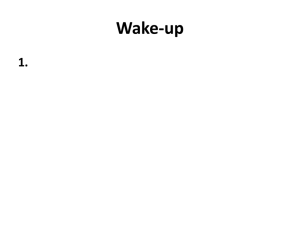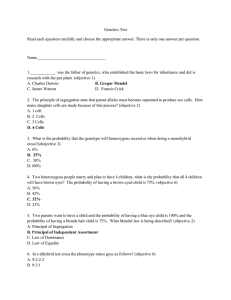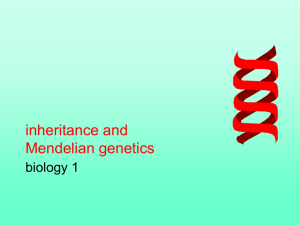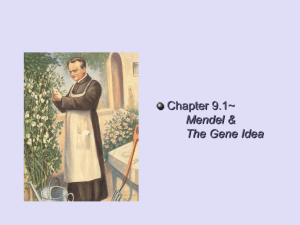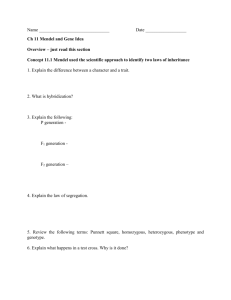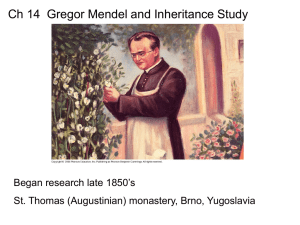Genetics: Part I Mendel and the Gene
advertisement
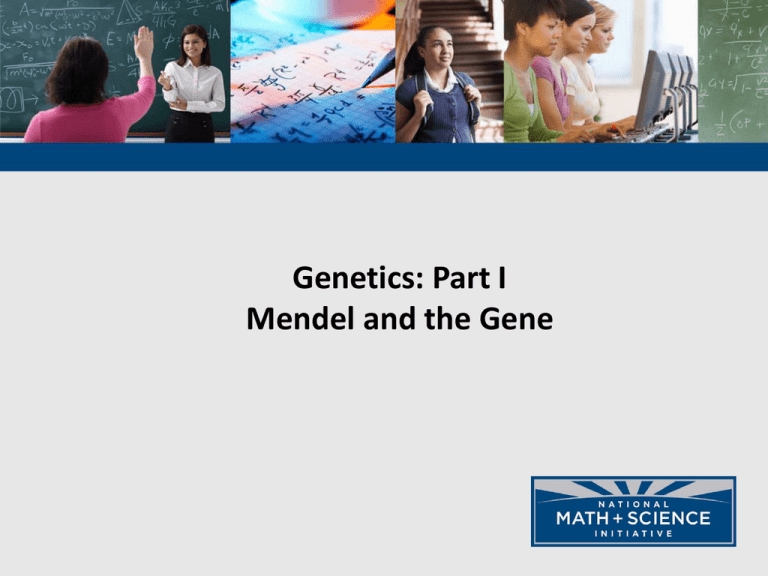
Genetics: Part I Mendel and the Gene Colorblindness Marfans Syndrome Polydactyly Freckles Cleft chin Widows peak 2 Mendelian Genetics What do you remember about Mendel and his genetics studies from your first biology course? What are some of the terms of genetics that you remember? 3 Can you define these? • • • • • • • Genotype Phenotype Monohybrid Dominant Recessive P1 Homozygous • • • • • Heterozygous Allele Test cross F1 F2 4 3 Phenotype Genotype Purple PP (homozygous) Purple Pp (heterozygous) 1 2 1 Purple Pp (heterozygous) White pp (homozygous) Ratio 3:1 Ratio 1:2:1 1 Figure 14.1 P p Curriculum Framework 3. The pattern of inheritance (monohybrid, dihybrid, sex-linked, and genes linked on the same homologous chromosome) can often be predicted from data that gives the parent genotype/ phenotype and/or the offspring phenotypes/genotypes. Mendelian Genetics • Law of Dominance - if the two alleles at a locus differ, then one (the dominant allele) determines the organism’s appearance, and the other (the recessive allele) has no noticeable effect on appearance 12 Human Traits with simple dominance: • • • • • • • Widows peak Handedness Free earlobes Cleft Chin Dimples Freckles PTC testing • • • • Polydactyly Bent little finger Nearsightedness Mid-digit hair 13 Dominant does not mean numerous Frequency of Dominant Alleles • Dominant alleles are not necessarily more common in populations than recessive alleles • For example, one baby out of 400 in the United States is born with extra fingers or toes In humans, alleles for dark hair are genetically dominant, while alleles for light hair are recessive. Which of the following statements is/are most likely to be correct? a. Dark hair alleles are more common than light hair alleles in all areas of Europe. b. Dark hair alleles are more common than light hair alleles in southern Europe but not in northern Europe. c. Dark hair alleles are equally common in all parts of Europe. d. Dark hair is dominant to light hair in southern Europe but recessive to light hair in northern Europe. Curriculum Framework b. Segregation and independent assortment of chromosomes result in genetic variation. 1. Segregation and independent assortment can be applied to genes that are on different chromosomes. 2. Genes that are adjacent and close to each other on the same chromosome tend to move as a unit; the probability that they will segregate as a unit is a function of the distance between them. Mendelian Genetics • Law of segregation: the two alleles for a heritable character separate (segregate) during gamete formation and end up in different gametes 17 Figure 14.7 TECHNIQUE Dominant phenotype, unknown genotype: PP or Pp? Predictions If purple-flowered parent is PP Sperm p p Recessive phenotype, known genotype: pp or If purple-flowered parent is Pp Sperm p p P Pp Eggs P Pp Eggs P p Pp Pp RESULTS All offspring purple Pp Pp pp pp or 1/ 2 offspring purple and 1/ offspring white 2 Figure 14.8 EXPERIMENT YYRR P Generation yyrr yr Gametes YR F1 Generation Predictions YyRr Hypothesis of dependent assortment Hypothesis of independent assortment Sperm or Predicted offspring of F2 generation 1/ Sperm 1/ 2 YR 1/ 2 2 YR YyRr YYRR Eggs 1/ 2 1/ 4 YR 4 Yr 4 yR 4 yr Eggs yr YyRr 3/ yyrr 1/ 4 YR 1/ 4 1/ Yr 4 yR 1/ 4 yr yr 1/ 1/ 4 1/ YYRR YYRr YyRR YyRr YYRr YYrr YyRr Yyrr YyRR YyRr yyRR yyRr YyRr Yyrr yyRr yyrr 4 Phenotypic ratio 3:1 1/ 9/ 16 3/ 16 3/ 16 1/ 16 Phenotypic ratio 9:3:3:1 RESULTS 315 108 101 32 Phenotypic ratio approximately 9:3:3:1 Independent Assortment 20 Practice • In order to solidify your ability to explain the Laws of Segregation and Independent Assortment, describe how these laws would apply as sperm cells are developed in a man with genotype RrSs. • Draw an image to support your explanation. 21 Sample image 22 Imagine crossing a pea heterozygous at the loci for flower color (white versus purple) and seed color (yellow versus green) with a second pea homozygous for flower color (white) and seed color (yellow). What types of gametes will the first pea produce? a. two gamete types: white/white and purple/purple b. two gamete types: white/yellow and purple/green c. four gamete types: white/yellow, white/green, purple/yellow, purple/green d. four gamete types: white/purple, yellow/green,white/white, and purple/purple
